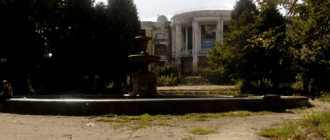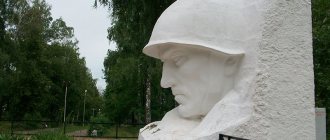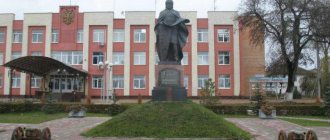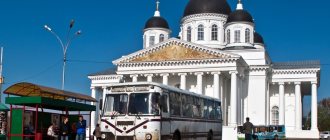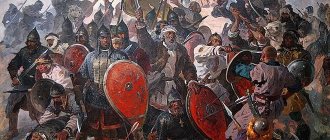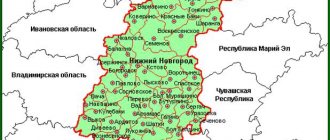Bogorodsk: areas, recreation, excursions, museums and churches, cuisine and restaurants, shopping and shops, attractions of Bogorodsk.
- Last minute tours
to Russia
In 1570, Tsar Ivan the Terrible defeated the Novgorod freemen, executed some of them, and resettled others in other regions. About 300 Novgorodians settled near the road from Murom to Nizhny Novgorod. The new village received its name from the Church of the Blessed Virgin Mary, and its streets were named, according to Novgorod custom, according to the occupation of their inhabitants and were called “ends”: Pottery End, Udaloy End, etc.
In the 17th century Leather industry enterprises arose in Bogorodskoye, becoming famous throughout Russia for their saddlery goods and appalling working conditions in factories.
Entertainment and attractions of Bogorodsk
Today's Bogorodsk has retained in its appearance the features of a wealthy large village: well-built merchant mansions, shop premises, some of which are still used as retail space. The new Church of the Intercession of the Virgin Mary (16 Venetskogo St.) also reminds us of antiquity, despite the fact that it was built in the 1990s. Its blue and white building with golden domes became the architectural and spiritual center of the city.
In 2003, a healing spring was built in Bogorodsk, and next to it a chapel was built in honor of the Holy Equal-to-the-Apostles Prince Vladimir. It was consecrated in front of a large crowd of people, and it was during this holiday that the beginning of the Russian church-wide movement “Return to Origins” was laid.
Almost in the center of the city there is a small but quite picturesque lake Kabatskoye. It seems that time has frozen on its shores: just like a hundred years ago, two-story wooden mansions and the crowns of old trees are reflected in the surface of the lake.
Main streets of Bogorodsk
Today there are about 170 streets in the city. A detailed map of Bogorodsk will show not only major highways, but also small streets.
- Lenin Street. The main street of Bogorodsk.
It starts in the 2nd microdistrict from the intersection with Turkova Street.
It runs along the New Park.
Intersects with Molodezhnaya, Shchorsa, Shevchenko, Lermontov streets, Udalovsky Lane, Polevaya, Ulitskogo, Brenzissa, Kalinin streets.
It runs through the Central District of Bogorodsk, the district administration, Central Square, intersecting with Kotelnikov and Red Square streets.
Intersects with Leninsky, Kuznechny, Kopylov Shchurkin, Glukhim, Dudenevsky, Poksovsky lanes, Leninskaya site street.
It ends at the merger with Nizhny Novgorod Highway.
- Chernyshevsky street.
It starts from microdistrict 2, runs parallel to Lenin Street past the New Park, in which the Pobeda sports and recreation center is located. Intersects with Chernyshevsky Lane, Polevaya, Sportivnaya streets.
It ends with a transition to Lunacharsky Street.
- Karl Marx Street.
It originates from the intersection of Oktyabrskaya and Sakko streets, intersects with Karl Marx, Pesochny, Kuznechny, Dudenevsky lanes. It ends at the intersection with Poksovsky Lane.
- Kashina street.
Starts from the intersection with Zagorodnaya Street.
Intersects with the streets of Mira, Gaidar, Pervomaiskaya, Novaya, Chkalov, Liebknecht, Uritsky, Volodarsky, Bragin, Pravda. It ends at the intersection with Kotelnikov Street.
- Mechanizer Street.
It originates from the intersection with Polevaya Street.
It runs along the railway and Kozhevennoye station.
Intersects with Rodionova Street.
It ends with a transition to 2nd Vokzalnaya Street.
Museums of Bogorodsk
The Bogorodsk City Historical Museum is open daily, except Mondays, from 8:00 to 17:00. Here you can get acquainted with the history of the city and learn about how leather and pottery crafts developed in the region. The museum is located on the street. Frunze, 2.
At the Museum of Contemporary Ceramics, you can take a master class on working on a pottery wheel and buy objects created in the museum’s workshop. The exhibition presents products of ceramicists from all over Russia, which allows you to compare different styles, traditions and decoration techniques. The museum is located in the House of Crafts and is open by prior arrangement (222 Lenina St., tel. +7 (83170) 2-15-57). You can also attend the most interesting master classes during the annual festival “City of Potters” (in early July).
The quiet town of Bogorodsk, Nizhny Novgorod region. Photo of Bogorodsk.
Some people like big, noisy cities with great opportunities, elite achievements of civilization, higher pedestals and palms, while others do not need the hustle and bustle of vanities and live quietly in a modest small town in the Russian outback. Take a walk along a quiet street in Bogorodsk in summer. It is amazingly quiet there, you are unlikely to even meet passers-by.
For hundreds of years, private houses have been built there this way and this is exactly what wooden gates look like.
Sleepy streets, sleepy trees, growing freely here for hundreds of years.
Sleepy dogs on blue piles of leather scraps.
There is almost no work in the city. Basically, everyone goes to Nizhny and works where Nizhny Novgorod residents do not want to work. By the way, nowhere in the world, probably except Bogorodsk, are furnaces heated with tannery waste of this type.
Previously, a bunch of such blue fuel - chrome-plated leather production waste - lay in every home. Early in the winter, the whole city usually smells of a kind of fumes from burning these scraps of leather. I suspect that it is extremely toxic.
The main thing for a Bogorodian is his car. This is both social status, and a measure of success, and weight in society. If you don’t want to be known as a “loser,” go broke, but buy yourself a neat foreign car.
By the way, Bogorodsk residents drive desperately through the narrow, dilapidated streets, regardless of passers-by and other annoying little things. There are almost no sidewalks anywhere, so you will be lucky if in a dirty winter you are only doused with a dirty fuel oil wave from under the wheels of a tough aborigine - the best thing to do from him is to immediately dive into a snowdrift to save your own life.
There are quite expensive private houses in the city, but this is rare. Basically, people cannot afford to break out of the framework of a rather ascetic lifestyle. Here is an ordinary Bogorodskovskaya street.
People trade at the market from 5 am, and by 12 people are already leaving. The product is simple: seasonal vegetables and other fruits and vegetables. They are actively collecting mushrooms: a good help for village residents.
There are few buyers, so many will have to take the goods home.
The city center includes a central market and a department store.
And, of course, the church.
The temple is beautiful and well maintained. Bogorodsk is an amazingly religious city. In his conservatism, he proved impenetrable to adherents of anti-religious policies of various stripes in all the years of his existence. People were forced to attend Sunday Sundays on Easter, a public bathhouse was opened only on major Orthodox holidays, and they were forced to listen to lectures with anti-religious propaganda.
All in vain! People looked at the propaganda with disbelief; at best, only one person came to the bathhouse on Easter! people, and children were baptized en masse in surrounding churches even by communist leaders.
I am glad that the Judaizing commies apparently did not get around to renaming the wonderful name of the city in honor of the patroness of the Orthodox - the Mother of God - Bogorodsk, Bogoroditsk. Otherwise it would have been some disgusting “Uritsk” or “Libknekhtsk”. The road to the temple is paved with tiles, and there is a flower garden around it.
Do not destroy the general mood of the townspeople here. There is no need to tell them about wonderful places in the world. They don't need mountains and oceans. They are above philosophical teachings and are holistic in their immaculate asceticism.
The grandmothers are dressed in the same way as they were 60 years ago: simple stockings (and where do they buy them?), duvets, a skirt, a scarf, a knitted jacket and a wooden footrest.
The usual outfit of an ordinary granny from Bogorodsk will not change for another hundred years.
The fashion for wigs, short and long hairstyles, and square hairstyles comes and goes in the world. The shoes have round and pointed toes, but the Bogorodskovsky grandmothers will have a headscarf on their heads, shoes on their feet, and a wooden footrest in their hands.
Son, can you tell me how to get to the tee box?
And it’s great that here, in the small towns of Russia, neither fire, nor sword, nor a fiery word can burn out from the people this desire to live inconspicuously, without snatching stars from the sky. It is difficult to seduce a people who have once accepted Orthodoxy with all their souls and who do not exchange their Faith for Western coins.
But Orthodoxy here can only be eradicated together with these very people.
And people have been living in nondescript houses since time immemorial.
From behind the tulle curtains they look at the world: “Who passed?”
The rain has been pattering for decades on tatty roofs that cannot be repaired.
The roofs of the barns are collapsing.
They are trying to somehow decorate the front gardens.
For some reason, they don’t pick abundantly ripe cherries. Maybe sugar is expensive?
But there is no one to mow the grass: men don’t live here long.
This “entrance” will collapse in 2 winters.
Laying asphalt is an expensive business, and the authorities, as always, have no money.
But they don’t skimp on cars.
Everyone who can is trying to install gas. Firewood is expensive, and tanning waste is almost non-existent. The city-forming enterprises - 3 tanneries that fed the city - were destroyed in the 90s and were never restored.
And unpretentious grannies live in unassuming houses. They pray in the mornings and evenings, drink tea, count on a meager pension for a month and do not complain about anything for hundreds of years, just like their grandmothers once did under the king, who also did not have the funds to improve the city.
And behind the dilapidated fences there is a quiet, unpretentious life.
Birch trees are very popular in Bogorodsk. They fill the quiet summer streets of the city with their gentle noise.
Surprisingly, there are practically no people on the streets; life glimmers only in the center.
The windows are hidden behind green thickets.
And on the eaves sleep calm cats of the yard color; in this sleepy swell of the city they are sure that no one will disturb them.
And let nothing disturb this city, no shocks. And everyone here has long been accustomed to a poor lifestyle, so it’s unlikely to surprise Bogorodsk with sanctions or slogans.
on Sunday, August 09, 2015. Posted in Photo
Bogorodsk Nizhny Novgorod report photo
Similar articles
- Spring in Nizhny Novgorod
- Beautiful development of the center of Nizhny Novgorod
- Lyskovo, Nizhny Novgorod region. Blogger's view and photo
- New Year in the city of Bogorodsk
Neighborhoods of Bogorodsk
In the immediate vicinity of the city (5-12 km) in the villages of Lazarevo, Podvyazye, Savelovo, Kudreshki, Lukino, Shapkino, you can see typical noble estates of the 17-18 centuries, which previously belonged to Russian noble families. Many of them are well preserved and have some historical and cultural value.
In the east of the Bogorodsky district there is the Oransky Monastery, the main shrine of which is the miraculous icon of Our Lady of Vladimir of Oransk, which is considered healing. According to legend, she saved Nizhny Novgorod. City tourist offices offer day trips to the village of Oranki, where the monastery is located. The cost of the excursion is about 1200 RUB including transfer. Prices on the page are for August 2022.


